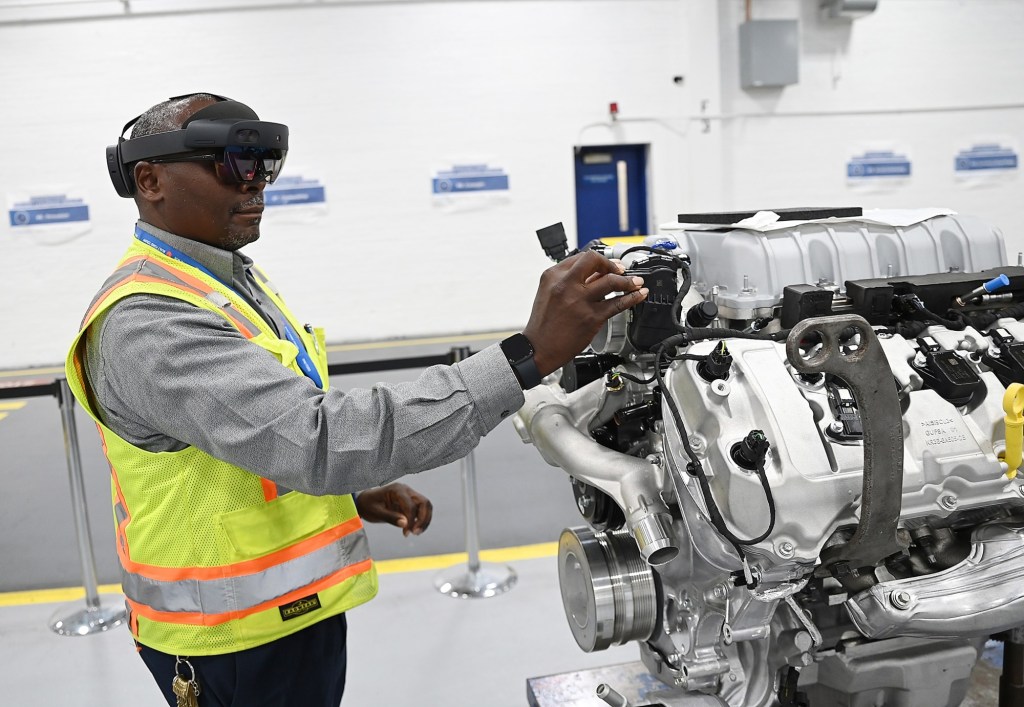Breana Noble | (TNS) The Detroit NewsArtificial intelligence-powered photographic inspections, 3D-printed tools and augmented-reality training headsets are part of Ford Motor Co.’s strategy to improve vehicle quality, something that has continued to plague its financial results.The Dearborn automaker in the second quarter was slammed with a more than 5% decline year-over-year in net income after warranty costs on pre-2021 vehicles unexpectedly ballooned. The hit comes following years of negative financial effects from poor quality results on its vehicles — a key area the company has been seeking to address with new leadership, revamped manufacturing systems and advanced technology.Slower vehicle launch and ramp-up processes are costing the company — the new procedures on the launch of the Super Duty last year cost Ford about $1 billion. But Ford executives say it’ll be worth it to yield better results and that with each launch under its new industrial system, the process becomes smoother and less costly. The brand jumped 14 spots on J.D. Power’s 2024 U.S. Initial Quality Study to No. 9 from No. 23.“To see a full market brand make a big shift like that is significant,” said Frank Hanley, J.D. Power’s senior director of auto benchmarking, though he noted Hyundai also jumped 14 spaces to No. 3 from No. 17. “The biggest thing is the organization’s commitment to quality. When they commit to changes they are going to make, they have to have this whole organization — design, product planning, the manufacturing facilities — everybody has to be in to improve.”More in-depth quality checks, improving the flow of communication to address issues more quickly and reforming its purchasing approach are part of that effort at Ford.Hanley points to physical indications of the company’s commitment to quality and its determination to instill the culture needed to succeed. The tools Ford is implementing include those that the automaker says better train and upskill workers, provide employees the resources to do their jobs more efficiently, and identify issues before a vehicle or part moves to its next station.AI camerasOne example is the implementation of Mobile Artificial Intelligence Vision System, or MAIVS. Using cameras found in smartphones and available artificial intelligence technology, Ford engineers implemented the system to talk to Ford software and capture images of, for example, a parts kit. The technology checks the photos against a library of images to determine whether the assembly is correct. If it’s not, the part kit halts at the station until it’s fixed.The Mobile Artificial Intelligence Vision System, (MAIVS) used for photographing the motor housing after completion of assembly at Ford’s Van Dyke Electric Powertrain Center on Aug. 5, 2024, in Sterling Heights, Michigan. (Clarence Tabb Jr./The Detroit News/TNS)About 20 plants globally have more than 300 stations installed with MAIVS, and it conducted more than 60 million inspections last year. Van Dyke Electric Powertrain Center in Sterling Heights was the first powertrain plant to incorporate the technology in its operations. The plant, which churns out transmissions and e-motors for vehicles like the Escape, Maverick and Transit as well as the all-electric F-150 Lightning and E-Transit, has roughly 10 stations equipped with MAIVS.In one use, the system evaluates squish tubes, which are round rubber seals in electric oil pumps that cool hybrid vehicle motors. In 2023, an average of 35 pumps per month had squish tube defects that were going into transmissions, and there was an all-time high of 63 rejects in June of that year. After installing MAIVS this January, the number of rejections fell from 26 in December to 17 in January to 13 in February and zero in March, where it has stayed through the spring and summer.“With a lot of these tools and implementations,” said Hayley Garnham, Van Dyke’s quality manager, “we can make sure that right there at that station, any issue that they had, OK, is cut off so that problem part can’t be passed forward.”3D printingAlso at Van Dyke and other plants, Ford is leveraging additive manufacturing to 3D print tools that operators can use to ease their jobs and keep parts organized and easily accessible. This helps jobs be done in a consistent fashion with the correct pieces and more efficiently, plant manager Mark Shkoukani said.The Van Dyke plant alone has two large 3D printers and a smaller one mostly for prototypes that run 24 hours a day, said Bill Colwell, lead process engineer. The printing can take 20 minutes to a few hours, depending on the size of the tool. Typically there are six projects in the queue, and workers approach with ideas on a daily basis.An employee working on the line can come to Colwell or one of his colleagues when they have an idea for a tool. Together, they’ll sketch out a design, which Colwell uses then to create a design that the 3D printer can produce, typically with plastic. The process can put a tool in the hands of an operator within a day compared to in the past when Ford would have to go through a supplier, which could take weeks or even months if further adjustments had to be made.“We can implement something within a few hours, try it out, and if it doesn’t work,” Colwell said, “we can go right back and take the same model we already had and print it right away and just make slight changes to it.”Chris Kipp, 52, UAW team leader at the eMotor Rotor Dept., assembles a rotor using a 3D seating tool with end caps at Ford’s Van Dyke Electric Powertrain Center on Aug. 5, 2024, in Sterling Heights, Michigan. (Clarence Tabb Jr./The Detroit News/TNS)Chris Kipp, 52, of Mount Clemens, a United Auto Workers team leader at the Van Dyke plant, collaborated with engineers to design a tool that allows workers to push easily into place the end cap of a rotor, a part in an electrified drive unit. A tool they originally used required a lot of force to push down the component. Kipp and engineers found that by making a tool that leverages the part’s inner diameter instead of the exterior, it offered stability that required less force to put the cap in place. As a result, the task whose length of time varied significantly and could take more than two minutes to complete became less variable and done in under 80 seconds.“It’s so much easier,” Kipp said. “Operators really felt it in their shoulders.”On a recent morning, Tyler Amodeo, 30, of Sterling Heights, an assembler at the Van Dyke plant, was using multiple 3D tools to perform his job. One holder for wave springs allowed him quickly to grab the large, thin washers without them becoming a tangled mess. He put a number of parts into a 3D-printed kit that keeps components on a pallet organized as it’s sent off to the powertrain line.“It helps me to be organized, efficient and faster,” Amodeo said.Tyler Amodeo, 30, an assembler at Ford’s Van Dyke Electric Powertrain Center uses a 3D cover plate during the assembling of a motor housing at the plant on Aug. 5, 2024, in Sterling Heights, Michigan. (Clarence Tabb Jr./The Detroit News/TNS)That’s key, Shkoukani said, because when employees don’t have the tools or parts they need, they have to take the time to track down the right part and ensure they get the correct one.“You eliminate a couple of footsteps,” he said. “When you do that on multiple stations down the line, you just do the math: It’s times so many. It’s just a huge save.”AR trainingHeading Downriver, Dearborn Engine also has implemented technology in an effort to yield positive quality results by augmenting employee training with Microsoft HoloLens, whose second-generation model retails starting at $3,500. The plant has incorporated the augmented-reality goggles into its training curriculum alongside written instructions, observation of someone else doing the job and on-screen 3D models. A collaborative study with the Georgia Institute of Technology showed that the mixed-reality step helped with muscle memory, plant manager Nadeem Zaidi said.That’s particularly important, because while Ford has strengths as a high-volume manufacturer, Zaidi said, the Dearborn plant has added more niche powertrain lines since its retooling when production relaunched in 2021. As a result, there are few engines produced on those lines, which means it takes longer for the job to become second nature.The plant also is working toward training more employees on jobs they’ve never done, from assembly to machining, Zaidi said: “It helps us distribute the manpower according to the people that are present for work.”The hope, he said, is that HoloLens will help ease that process. Wearing the headset, a trainee receives written step-by-step pop-up instructions that can explain how to inspect an F-150 Raptor R V-8 engine, for example. Virtual lines guide the user where to look, and the user can have the instructions follow them or stay still in a certain spot.“The biggest asset from my perspective is it takes a complicated job and breaks it down into very small steps, and if you follow the process, you will get to the end,” said Al Fisher, launch coordinator. “Sometimes an expert can take for granted how good he is. It doesn’t do that. It’s going to walk you through methodically step-by-step.”That can be helpful in instances where a worker’s expertise in an area is limited. At one point, the plant had one expert who could inspect a certain I-4 engine without instructions.“If that one expert is not in the plant, then … you’re kind of scrambling to get the inspections done,” said Tim Mwenje, Ford Production Systems coach. “When you put this on, even I could inspect it.”More than 20 employees at Dearborn Engine have been trained using the HoloLens, and Ford in July began tracking the performance of a single team where each member has been trained with the technology. Its application is expanding and being explored at other locations, too, including Dearborn Truck Assembly Plant, Rawsonville Components Plant in Ypsilanti and Louisville Assembly Plant in Kentucky.“I wish we had this when I was 18 and just starting out,” said Reginald Bassett, 42, of Redford Township, a team leader at Dearborn Engine. “I’m a very visual person, so it’s pretty cool.”©2024 www.detroitnews.com. Visit at detroitnews.com. Distributed by Tribune Content Agency, LLC.
How Ford is using AI, augmented-reality and 3D printing to improve quality – Press Enterprise




